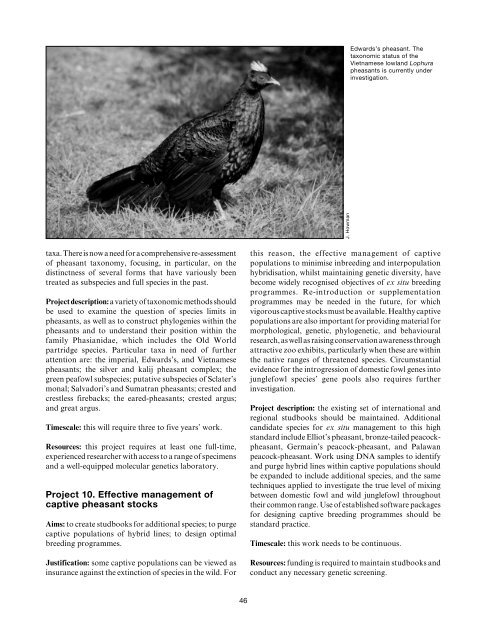Pheasants: Status Survey and Conservation Action Plan ... - IUCN
Pheasants: Status Survey and Conservation Action Plan ... - IUCN
Pheasants: Status Survey and Conservation Action Plan ... - IUCN
Create successful ePaper yourself
Turn your PDF publications into a flip-book with our unique Google optimized e-Paper software.
Edwards’s pheasant. The<br />
taxonomic status of the<br />
Vietnamese lowl<strong>and</strong> Lophura<br />
pheasants is currently under<br />
investigation.<br />
J. Howman<br />
taxa. There is now a need for a comprehensive re-assessment<br />
of pheasant taxonomy, focusing, in particular, on the<br />
distinctness of several forms that have variously been<br />
treated as subspecies <strong>and</strong> full species in the past.<br />
Project description: a variety of taxonomic methods should<br />
be used to examine the question of species limits in<br />
pheasants, as well as to construct phylogenies within the<br />
pheasants <strong>and</strong> to underst<strong>and</strong> their position within the<br />
family Phasianidae, which includes the Old World<br />
partridge species. Particular taxa in need of further<br />
attention are: the imperial, Edwards’s, <strong>and</strong> Vietnamese<br />
pheasants; the silver <strong>and</strong> kalij pheasant complex; the<br />
green peafowl subspecies; putative subspecies of Sclater’s<br />
monal; Salvadori’s <strong>and</strong> Sumatran pheasants; crested <strong>and</strong><br />
crestless firebacks; the eared-pheasants; crested argus;<br />
<strong>and</strong> great argus.<br />
Timescale: this will require three to five years’ work.<br />
Resources: this project requires at least one full-time,<br />
experienced researcher with access to a range of specimens<br />
<strong>and</strong> a well-equipped molecular genetics laboratory.<br />
Project 10. Effective management of<br />
captive pheasant stocks<br />
Aims: to create studbooks for additional species; to purge<br />
captive populations of hybrid lines; to design optimal<br />
breeding programmes.<br />
Justification: some captive populations can be viewed as<br />
insurance against the extinction of species in the wild. For<br />
this reason, the effective management of captive<br />
populations to minimise inbreeding <strong>and</strong> interpopulation<br />
hybridisation, whilst maintaining genetic diversity, have<br />
become widely recognised objectives of ex situ breeding<br />
programmes. Re-introduction or supplementation<br />
programmes may be needed in the future, for which<br />
vigorous captive stocks must be available. Healthy captive<br />
populations are also important for providing material for<br />
morphological, genetic, phylogenetic, <strong>and</strong> behavioural<br />
research, as well as raising conservation awareness through<br />
attractive zoo exhibits, particularly when these are within<br />
the native ranges of threatened species. Circumstantial<br />
evidence for the introgression of domestic fowl genes into<br />
junglefowl species’ gene pools also requires further<br />
investigation.<br />
Project description: the existing set of international <strong>and</strong><br />
regional studbooks should be maintained. Additional<br />
c<strong>and</strong>idate species for ex situ management to this high<br />
st<strong>and</strong>ard include Elliot’s pheasant, bronze-tailed peacockpheasant,<br />
Germain’s peacock-pheasant, <strong>and</strong> Palawan<br />
peacock-pheasant. Work using DNA samples to identify<br />
<strong>and</strong> purge hybrid lines within captive populations should<br />
be exp<strong>and</strong>ed to include additional species, <strong>and</strong> the same<br />
techniques applied to investigate the true level of mixing<br />
between domestic fowl <strong>and</strong> wild junglefowl throughout<br />
their common range. Use of established software packages<br />
for designing captive breeding programmes should be<br />
st<strong>and</strong>ard practice.<br />
Timescale: this work needs to be continuous.<br />
Resources: funding is required to maintain studbooks <strong>and</strong><br />
conduct any necessary genetic screening.<br />
46
















